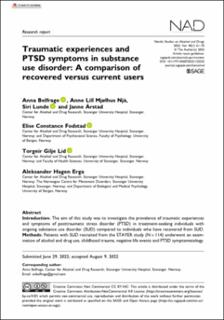| dc.contributor.author | Belfrage, Anna | |
| dc.contributor.author | Njå, Anne-Lill Mjølhus | |
| dc.contributor.author | Grude Fodstad, Elise Constance | |
| dc.contributor.author | Lunde, Siri | |
| dc.contributor.author | Årstad, Janne | |
| dc.contributor.author | Lid, Torgeir Gilje | |
| dc.contributor.author | Erga, Aleksander Hagen | |
| dc.date.accessioned | 2023-04-17T11:07:34Z | |
| dc.date.available | 2023-04-17T11:07:34Z | |
| dc.date.created | 2022-12-09T11:00:56Z | |
| dc.date.issued | 2023 | |
| dc.identifier.issn | 1455-0725 | |
| dc.identifier.uri | https://hdl.handle.net/11250/3063306 | |
| dc.description.abstract | Introduction: The aim of this study was to investigate the prevalence of traumatic experiences and symptoms of posttraumatic stress disorder (PTSD) in treatment-seeking individuals with ongoing substance use disorder (SUD) compared to individuals who have recovered from SUD.
Methods: Patients with SUD recruited from the STAYER study (N = 114) underwent an examination of alcohol and drug use, childhood trauma, negative life events and PTSD symptomatology. In this study, only participants with 12-month concurrent polysubstance use was included. Using historical data from the STAYER study, alcohol and drug trajectories were dichotomised as (1) current SUD (current SUD) or (2) recovered from substance use disorder (recovered SUD). Crosstabs and chi-tests were used to measure differences between groups.
Results: Childhood maltreatment, traumatic experiences later in life and symptoms of concurrent PTSD were highly prevalent in the study population. We found no significant difference between the current and recovered SUD groups. Recovered women reported a lower prevalence of physical neglect (p = 0.031), but a higher prevalence of multiple lifetime traumas (p = 0.019) compared to women with current SUD. Both women with current SUD and recovered women reported a significantly higher prevalence of sexual aggression than men (p < 0.001 and p < 0.001, respectively). In addition, men who have recovered from SUD reported a lower prevalence of PTSD symptoms over cut-off 38 (p = 0.017), of re-experiencing (p = 0.036) and of avoidance (p = 0.015), compared to recovered women.
Conclusion: Reported trauma did not differ between persons with current SUD and those who had recovered from SUD. Gender differences discovered in this study indicate the importance of developing individualised and gender-specific treatment models for comorbid PTSD/SUD. | en_US |
| dc.language.iso | eng | en_US |
| dc.publisher | Sage | en_US |
| dc.rights | Navngivelse-Ikkekommersiell 4.0 Internasjonal | * |
| dc.rights.uri | http://creativecommons.org/licenses/by-nc/4.0/deed.no | * |
| dc.title | Traumatic experiences and PTSD symptoms in substance use disorder: A comparison of recovered versus current users | en_US |
| dc.type | Journal article | en_US |
| dc.type | Peer reviewed | en_US |
| dc.description.version | publishedVersion | en_US |
| dc.rights.holder | Copyright 2023 The Author(s) | en_US |
| cristin.ispublished | true | |
| cristin.fulltext | original | |
| cristin.qualitycode | 1 | |
| dc.identifier.doi | 10.1177/14550725221122222 | |
| dc.identifier.cristin | 2091118 | |
| dc.source.journal | Nordic Studies on Alcohol and Drugs (NAD) | en_US |
| dc.source.pagenumber | 61-75 | en_US |
| dc.identifier.citation | Nordic Studies on Alcohol and Drugs (NAD). 2023, 40 (1), 61-75. | en_US |
| dc.source.volume | 40 | en_US |
| dc.source.issue | 1 | en_US |

